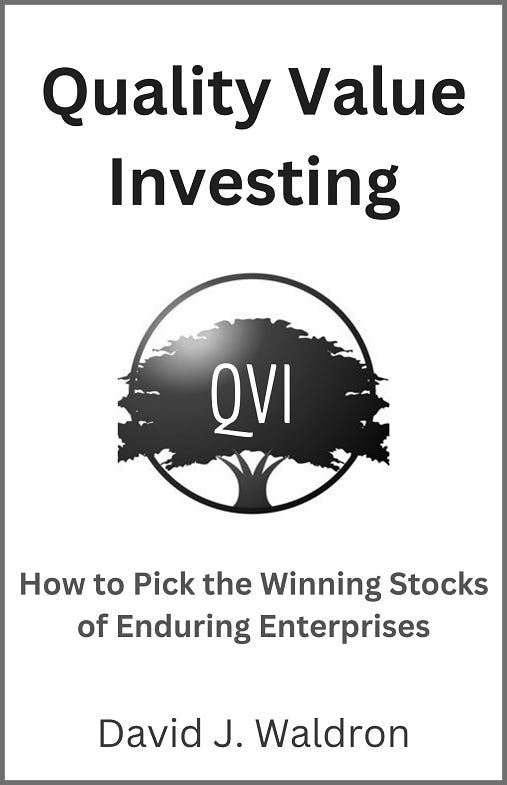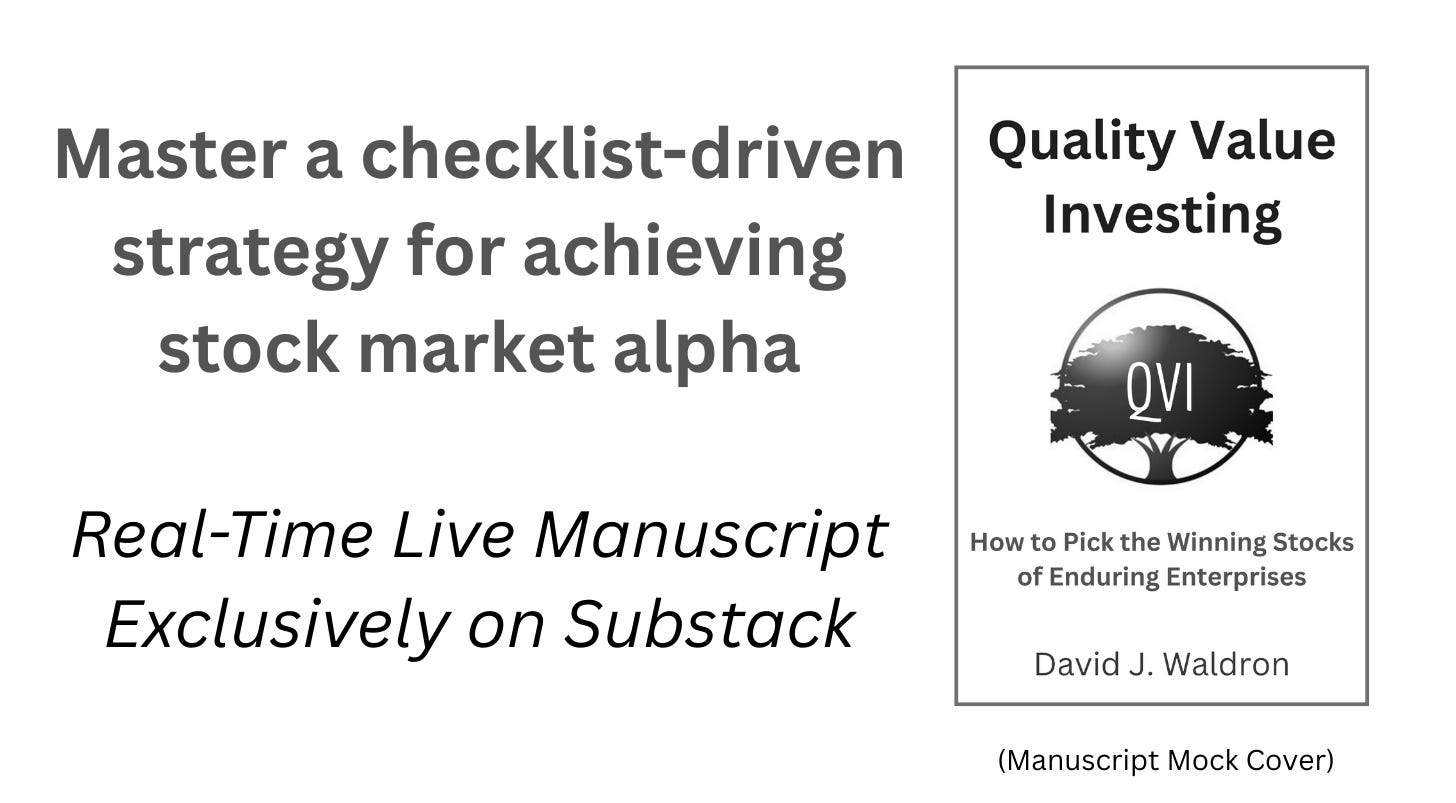Chapter Twelve: Master the Art of Behavioral Investing
Real-time final draft manuscript | Quality Value Investing: How to Pick the Winning Stocks of Enduring Enterprises
Audio voiceover:
Substack’s AI-generated voiceover is available from Books by David J. Waldron. To access it, open the chapter in the Substack app. Feel free to share your thoughts in the comments or via direct message. I will use AI to clone my voice for the book’s official audiobook release.
Learn more about audio voiceovers:
https://davidjwaldronbooks.substack.com/p/audio
Haven’t read the previous chapters? Find them here on the book’s webpages.
Books by DJW page:
https://davidjwaldronbooks.substack.com/p/quality-value-investing
QVI Page:
https://davidjwaldron.substack.com/p/quality-value-investing-upcoming
Chapter Twelve
Master the Art of Behavioral Investing
Rational thinking, discipline, and patience are crucial for successful stock market investing.
Many investors need to better understand the mental traps that can undermine stock picking and portfolio construction, whether managed professionally or by individual investors.
Mastering behavioral investing bridges the growing gap between psychology and finance.
Quality-driven value investors apply rational thinking to continually enhance their investment knowledge, demonstrating discipline in conducting thorough research to identify quality publicly traded companies with stock prices that offer wide margins of safety. They exercise patience while waiting for the compounding growth of capital gains and dividends to accumulate personal wealth over time.
The Art of Rational Investing
As much as the traditional way of stock-picking tries to persuade its followers otherwise, it is far from being rocket science.
In contrast, keeping investing super simple will benefit the beneficiaries of quality-driven stock portfolios. When the Wall Street fee machine insists that its complex and predictive investing paradigms are best, rational investors on Main Street remember that common sense prevails.
For better or worse, rational thinking emerges as the leading indicator for predicting the overall direction of a company's future performance and stock prices. Unfortunately, the Wall Street Way often hinders this because it can’t turn common sense and instinct into detailed sell-side research reports or buy-side quarterly notes for clients.
By concentrating on the facts — reading 10-Ks and researching a company’s value proposition, management’s returns, shareholder yields, valuation multiples, and downside risks — quality-focused investors evaluate whether it is worth becoming part owners of the business. They act when fundamentals are strong, the current share price is reasonable, and downside risks are generally low.
Why Predictive Analysis Is the Fool’s Game
Unfortunately, many investors continue to believe they can easily predict trends, catalysts, and macroeconomic events.
Their crystal balls, disguised in complex methodologies, predict future revenues, earnings estimates, and specific stock prices. History shows that such practices are a fool’s game.
On the contrary, rational investors avoid trying to predict specific future movements in company shares, whether through price targets or percentage gains and losses, leaving market speculators to engage in meaningless games of chance.
Rational investing often overlooks predictive equity analyses, such as calling “XYZ shares undervalued by 42 percent.” Common-sense investors disregard the illusion of forecasting exact percentage gaps, instead using research and judgment to determine that a stock generally appears to be mispriced.
When market timers are incorrect, the likely result of predicting unexpected market, industry, or company events is that significant assets are lost because traders keep positions too long or too short.
Conversely, rational investors are willing to seize the opportunity of a surprise event or black swan by deploying planned cash reserves into new or larger positions in value-priced shares of high-quality companies.
Placing Bets Contradicts Quality Value Investing
The market consensus represents the shared opinion of analysts, bloggers, portfolio managers, private investors, and senior executives regarding publicly traded stocks.
The contrarian believes the crowd is wrong about a company’s long-term prospects. While more research is needed to confirm or challenge the crowd’s view, the consensus can often serve as an intuitive sign for rational-thinking investors. However, placing bets and crossing fingers is the opposite of quality-focused investing.
Rational thought increases their chances of being right more often than wrong by applying common sense based on tangible current wealth and present value, rather than speculative future growth. Moreover, knowing that the Wall Street consensus is often irrational, rational investors avoid the temptation to interpret groupthink as a definitive buy or sell signal.
Buying and selling stocks based on trying to predict future events is no different from investing based on hope. Rational investors stick to facts and ignore subjective forecasts.
In Business, Rational Thinking Outperforms Emotion
Fickle retail investors and aggressive professional traders are often lost in the crowd, driven by raw emotions as they buy and sell investment securities to satisfy their thirst for quick profits. Such emotional investing leads to more losses than gains.
Too many investors — often driven by misguided passions rather than rational thinking — trade on geopolitical news and other macroeconomic events, usually for worse rather than better.
The good news is that irrational behaviors create profitable buying opportunities, though only temporarily, giving quality-driven value investors the chance to outperform the market over time.
Rational investors are wary of the talking heads for the sake of their portfolios. This chapter isn’t about current macroeconomic conditions or what one should buy, sell, hold, short, or exploit to beat the market in the short term, leaving that chatterbox to the financial entertainers. Instead, it focuses on silencing the noise coming from the markets and investing with rational thought and common sense by employing the proven strategy of buying value-priced portions of high-quality, enduring companies and then holding each for the long term as proud shareholders.
Investors who use rational thinking and a touch of common sense recognize that quarterly earnings, the daily news cycle, and other short-term events often create buying opportunities in shares of well-established, quality companies.
Conversely, many other investors tend to sell at a loss based on the latest report or event, letting raw emotion override reason. As in politics and business, rational thinking generally outweighs irrational feelings for value investors focused on quality.
Emotion-free, rational thinking combined with a touch of common sense often leads to success in investing for long-term capital gains and short-term dividend income.
The Art of Disciplined Investing
Alpha-achieving portfolios are achievable for disciplined, quality-focused investors.
Their research or due diligence concentrates on exceptional companies with ethical management that generate consistent, organic revenue growth, sustained profitability, abundant free cash flow, and high returns on equity and invested capital.
Investing in stocks is simple, although it is never easy. It is achievable but can be intimidating. Nevertheless, straightforward research combined with a disciplined approach to portfolio building, capital allocation, and dividend reinvestment has greater potential to outperform the market over a long-term holding period.
A profitable concentrated stock portfolio is akin to owning shares in companies that produce high-quality products or services with enduring competitive advantages.
Quality-focused investors take pleasure in selecting stocks and managing investments through thorough education and self-discipline. By concentrating their research on a few key metrics, combined with rational thinking and disciplined analysis, investors can outperform Wall Street’s fee-driven, sophisticated, and in-depth predictive analyses. This approach enables them to beat the market with lower costs and less risk, even with limited capital.
Get to Know the Business
Disciplined investors conduct bottom-up analyses to identify high-quality companies, regardless of the specific industry or unpredictable macroeconomic conditions.
They adhere to the proven method of researching the fundamentals of the target business to assess its potential ownership value.
Disciplined investors own companies with efficient and transparent management that maximize returns for all stakeholders, including customers, employees, and shareholders. They view themselves as owners of high-quality businesses, rather than merely accumulating electronic shares of common stock purchased instantly through an online discount broker. The actions are similar, but owning real companies feels more meaningful than trading faceless stocks.
Measuring actual returns on management or current wealth encourages disciplined investors to limit their capital to stocks of high-quality operators held for the long term. This approach enables them to benefit from the compounding returns generated by the enterprise’s management team, which comprises superior capital allocators.
Disciplined stock market investors enhance their chances of achieving market-beating total returns by focusing on fundamentals and disregarding the pressures from fast-money clients and quarterly results.
Instead, they purchase shares of stable, well-established companies when their stock prices are reasonable.
Commit to Fair Valuations
A reasonable statement is that disciplined investing requires a commitment to appropriate valuations.
Arguably, every investor who buys securities long believes that prices will rise by the end of the day, week, year, or decade. So, why do many struggle with valuation?
When buying stocks based on their present value, disciplined investors benefit from future growth. Conversely, investors or traders lacking discipline tend to pay more for securities. Why pay more?
Special situations or unexpected events often create buying opportunities for the common shares of quality companies that are likely to succeed despite short-term economic or industry setbacks. Disciplined value investors tend to wait for macroeconomic or microeconomic events to bring the stock down to a reasonable, if not bargain, price.
As day traders and momentum investors make daily decisions, disciplined investors thoughtfully analyze a company’s fundamentals, exercising patience to act only when the stock price is appealing.
Frustratingly, equities in a portfolio or on a watchlist often appear to be at fair value or overvalued to disciplined investors who focus on buying undervalued stocks of quality companies for long-term growth. Nonetheless, they continue to look for value regularly, as occasional surprise bargains tend to appear when least expected.
Disciplined, quality-focused value investors never try to predict a market, industry, or company event. Instead, they get ready to benefit from sudden drops in stock prices after they happen.
Understand and Accept the Risks Involved
Assessing downside risk is vital for the success of quality-focused investors.
Disciplined investors typically hold risk-averse shares of high-quality companies, leaving stock trading to risk-taking speculators. However, while undervalued shares of well-capitalized companies present rare opportunities in every market, each investment still involves risks.
Regardless of the cause or duration, any market downturn serves as a reminder that managing risk is crucial for disciplined investing. Similarly, any sudden market decline emphasizes the core principle of disciplined investing: understanding the downside risk profile of each holding.
Second-level investors tend to sell as stocks rise and buy when the market falls. The strategy used by these disciplined, value-driven investors profits from the mistakes of those who ignore clear lessons from market history.
Conversely, disciplined investors believe that a risk which has been assessed, understood, and properly managed is worth taking. They recognize that although returns are unpredictable, the risks are manageable.
Measuring, understanding, and accepting the downside risks of a company and its common shares in a challenging market provides the best opportunities for investing with a tolerable, asymmetric risk-reward profile. Often, successful investors are rewarded more for limiting portfolio downside in bear markets through disciplined risk management than for gains during bull markets driven by exuberant investors.
Disciplined behavioral investors generate profitable returns over their lifetimes by managing downside risk while allowing upside opportunities to emerge naturally.
The Art of Patient Investing
Patience is arguably the rarest — and therefore most valuable — commodity in the stock market. Quality-focused value investors benefit from this market inconsistency.
Slow and steady investors recognize that stable companies grow over the long run. Active traders frequently buy and sell based on good or bad news, often experiencing short-term losses. Rather than chasing risky stock trends, successful investors focus on great companies with long-term potential, benefiting from the power of compounding and wide safety margins. They look for high-quality stocks at reasonable prices.
It’s because patient investors understand that the common stocks of companies offering valuable, in-demand products and services tend to withstand market cycles, despite some erratic price fluctuations caused by the crowd’s short-sightedness.
Quality-Driven Value Investing Demands Patience
Investors or traders who require more patience may risk paying higher prices for the stocks they buy or sell before achieving their expected capital gains.
On the contrary, patient stock market investors know that if they wait long enough, their targeted quality companies — including some already in their portfolios and now trading at higher valuations since initial purchase — become available at bargain prices, even if only temporarily.
Unexpected macroeconomic events, company-specific issues, market declines, negative news, or quarterly earnings misses often create buying opportunities for patient, quality-focused value investors, rather than prompting panic selling in sync with the crowd.
Being a scarce and therefore valuable commodity, embracing patience is often the key difference between success and failure for stock market investors. Despite the significant challenge, practicing patience while waiting for investment theses to unfold is crucial for long-term success. Contrary to popular belief, generating wealth through short-term trading in financial markets is uncommon. However, perseverance is often rewarded.
Patient investors seek alpha by selecting companies with growth potential and a margin of safety to protect their capital. If they decide to invest, they calmly navigate market and company fluctuations, waiting for the investment thesis to unfold over the long term.
Investor patience shifts the conversation from the typical Wall Street focus on quarter-to-quarter reactions to revenue or earnings misses, toward a more intelligent investor approach of multiyear compounding returns on capital and dividends bought at reasonable share prices.
The lesson is that, although hindsight is invariably in the past, patience always awaits the future.
Patience Finds the Needles in the Haystack
Quality-driven value investing is akin to finding a needle in a haystack, so it requires considerable patience for long-term success.
Patient investors wait for the valuation multiples of enduring companies’ shares to fall to levels indicating temporary bargains. They stay alert to avoid blinking and missing those fleeting buying opportunities.
Despite conveying confidence, do market forecasters know what will happen to a market, a company, or a stock price at any specific time?
Historical capital gains in the common shares of enduring businesses come from occasional, sometimes sizable, increases in the stock price of high-quality companies, which accumulate over time. Patient investors more often experience this alpha, or the excess returns of an investment, compared to the benchmark index’s performance.
Patient investors focus on current wealth and present value, find the elusive needle, and then stick with it—no pun intended.
Be Willing to Invest and Hold Forever
Patient investors equate buy-and-hold forever with a steadfast commitment to quality companies and the common stocks that represent each.
Patient, quality-focused value investors buy low, hold high, and sell when they die.
They are willing to hold shares of great companies for a generation, benefitting from the magical compounding of capital gains and dividends. Conversely, selling when they pass away allows them to transfer the assets to their heirs and designated charities.
Patient investors challenge themselves to think ten to twenty years ahead, rather than the usual ten to twenty months or even ten to twenty days. However, from a long-term perspective, gains tend to accumulate gradually over time for patient investors who own shares in companies with enduring business models.
The buy-and-hold forever method pays off for these investors. Again, in terms of buying value now, they benefit from growth later.
Despite ongoing and relentless market noise, patient investors quietly observe a company’s business prospects while collecting dividends as the short-term reward for their perseverance in waiting for capital appreciation.
Patient, quality-focused value investors remain calm, waiting for opportunities to present themselves. And they usually do, eventually.
Master the Art of Behavioral Investing
A behavioral approach to investing in the stock market is solely cognitive.
This chapter explains how to effectively utilize cognitive behaviors, such as rational thinking, discipline, and patience, in a quality-driven stock-picking strategy that counters the apparent lack of these productive behaviors in the financial markets.
It is essential to remember that long-term results are the preferred method for evaluating equity performance by rational, disciplined, and patient investors seeking quality at a fair price.
They don’t have to chase quarterly performance, unlike many Wall Street players and their hordes of followers on Main Street. Instead, the skills of behavioral investing are the best allies of the quality value investor.
Investors who master behavioral investing look ahead and beyond, understanding that a legacy portfolio composed of shares in exceptional, lasting companies will continue to grow in the capable hands of loved ones.
Practitioners who practice the art of behavioral investing buy and sell to make a profit, not to suppress emotions. However, when purchasing high-quality companies at reasonable prices, there are fewer reasons to sell apart from funding significant life events, such as buying a home, paying for college, sponsoring a wedding, pursuing a hobby, starting a business, or planning a comfortable retirement.
They pursue alpha with careful reasoning, reserving emotion for celebrating wins or assessing losses after the trade—never beforehand. The lesson for investors is to avoid market timing and stock trading and instead focus on investing or divesting based on appropriate micro- and macroeconomic factors.
Achieving alpha in stock picking requires behavioral skills like rational thinking, self-discipline, and relentless patience throughout the entire investment process.
Next in Quality Value Investing | Chapter Thirteen: Achieve Stock Market Alpha
Chapter Twelve: Master the Art of Behavioral Investing is copyright 2025 by David J. Waldron. All rights reserved worldwide.
Universal links allow you to preview or purchase David’s published print, audio, or ebooks — each available globally at your preferred online bookstores — with one or two clicks, brought to you by our trusted partner, BookFunnel.
Share the author’s website, Books by David J. Waldron, with your network to earn credits for a premium subscription that offers full-text and audio access to all of David’s manuscripts and updated chapters of his published self-help books.







